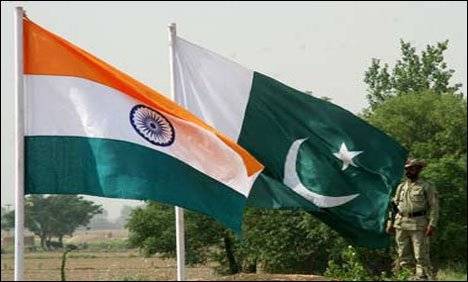Once again tensions between Pakistan and India, whipped by war hysteria in the media has created apprehensions of War between the two countries. The present tension has been triggered by the Uri incident in which 18 Indian soldiers were killed for which India blames Pakistan for abetting and sponsoring it. Pakistan denies this.
Pakistan believes that India without any evidence and is exploiting the incident it to distract the International Community’s attention from the human right atrocities being committed by it in Indian Occupied Kashmir.
Both countries are nuclear powers, which have substantially reduced any chances of a full-fledged conventional war. This has given rise to low intensity proxy wars between the states in Afghanistan, Baluchistan and Kashmir.
India’s military strategy was designed as a defensive doctrine where holding corps was to deny any enemy intrusion. However, with the 1962 Sino-Indian conflict and 1965 Pakistan-India war, the Sundarji doctrine brought about a paradigm change and strike corps were incorporated to mobilise from central India to counter any attack on the western border, and to penetrate into Pakistani territory.
The development of strategic nuclear weapons and the pitfalls of the 2001-02 standoff, India further modified its military doctrine into the pro-active Cold Start. Under this doctrine, strike corps are to be rapidly mobilized to penetrate deep into enemy territory with support from its combined arms operations before Pakistan has a chance to mobilize its defenses. Under the cold start regimen, India believes that it can conduct limited conventional warfare to ‘punish’ Pakistan without evoking Pakistan’s nuclear response and before pressure from the international community to reach a ceasefire. Although India’s doctrine may not be necessarily in place yet, large-scale arms purchases for expansion and modernization of its forces allude to its ambitions to achieve regional hegemony and superiority for accomplishing its grander strategic goals in the region.
Pakistan humiliating defeat at the hands of India in 1971 and India’s failed nuclear test in 1974 code named “smiling Buddha”, convinced Pakistani policy makers and planners for the need for a nuclear deterrence as India posed an existential threat to Pakistan.
Pakistan mobilized human and financial resources and focused on a nuclear program for production of nuclear weapons. Once Pakistan achieved Nuclear weapons it laid a clear doctrine that would only be used as deterrence against India Both, India and Pakistan became nuclear powers in 1998.
Despite both nations now harboring nuclear shields as a deterrent, low-intensity conflict was on the rise, hence leading to India’s development of the Cold Start doctrine. To counter this new assertive India, Pakistan has developed tactical nuclear weapons similar to NATO’s response to the Warsaw Pact in West Germany during the Cold War, and has signaled the possible use of tactical nuclear weapons (TNWs) in conventional battlefield theater operations in an event of foreign aggression.
India’s strategy to penetrate deep into Pakistani territory up to the Sutlej and Ravi rivers was similar to Soviet grand battle strategy intended to push NATO forces to the river Rhine in West Germany through a mass assault.
The introduction of TNWs and Pakistan’s development of various delivery systems has allowed it to credibly deter aggression from India at the conventional level by guaranteeing Mutually Assured Destruction (MAD). This is due to real risk of rapid escalation created by an environment, where nuclear thresholds may diminish significantly after the first use of TNWs in battlefield operations. Furthermore, Pakistan’s nuclear threshold is ambiguous, much like NATO’s policy on TNWs deployment during the cold war, thus making Indian military planners more cautious. Both nations are also in the process of developing second-strike capability or may already posses it. Therefore, mutually assured destruction remains relevant to the balance of power in South Asia to this day.
Even low intensity conflicts under nuclear overhang can escalate beyond the limited theater of control and create a ‘use it or lose it’ dilemma ultimately leading to use of nuclear weapons. In addition hostilities between the two neighbors risks creating instability and further polarization in one of the least economically integrated regions of the world.
The threat of transnational movements such as ISIS that thrive in unstable environments, should make both the nations realize common threats they face in the region. Pakistan has realized the threats posed by such transnational movements with the development of its ‘Threat Matrix’ which saw a paradigm shift in Pakistani national security thinking and the subsequent campaign along the Afghan border in 2014.
Neither Pakistan nor India can afford to be in this perpetual state of hostility. With India’s government revisiting the World Bank brokered Indus treaty and its refusal to attend the SAARC summit, the region is already heading towards a more unstable and unpredictable zone. Dialogue and engagement between both the countries and accelerating efforts to find common ground to resolve their disputes is the only way forward. Even without immediate results, a sustained dialogue can help governments on both sides; manage public perceptions and lower emotions and war mongering. In parallel with a sustained dialogue, both sides need to engage in measures for confidence building. In the military realm, the CBMs should encompass steps for a risk reduction and avoidance of arms race. Both sides should seriously consider a dialogue on mutual threat perceptions and military doctrines. Offensive doctrines like Cold Start should be eschewed and replaced with defensive doctrines and force postures. This will diminish the rationale for the other side for conventional and/or nuclear build ups and pave the way for strategic restraints, nuclear and missile, in South Asia. It will create a conductive environment for the sustainability of the dialogue for resolving long-standing disputes between the two neighbors faced by common challenges such as poverty, unemployment, climate change, and food security. The sooner decades old disputes are resolved, the sooner both nations can secure a brighter future for the region.






